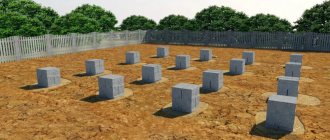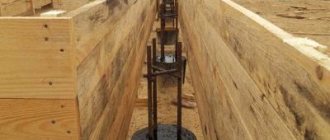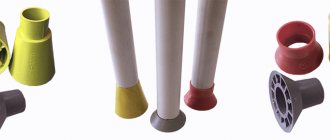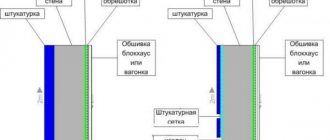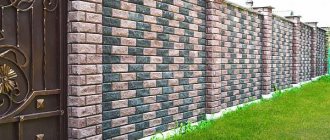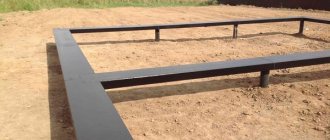Production of systems: – sewerage – water supply – drainage
- HomeArticlesArticles from NASHORNDo it yourselfFoundation
06.11.2015
Columnar foundation using PVC plastic pipes has the following advantages:
Low cost of construction due to the small volume of preparatory, excavation and concrete work, minimization of transport and loading and unloading services; High speed and ease of installation; Optimal load on the ground due to the best distribution of the weight of the building; Possibility of arrangement on heaving soils, areas that are regularly are subject to flooding, erosion by ground and flood waters; The plastic pipe in this type of foundation acts as a reliable and durable permanent formwork, which provides the structure with clear geometry in all respects; Durability of the formwork. If we consider a PVC pipe for external sewerage, then its service life, according to manufacturers, is at least 50 years; High resistance to aggressive environments.
Frost resistance; Lightweight, but at the same time have sufficient rigidity and strength; Wide variety of sizes. Diameter 110 mm – 630 mm. Length 1 m - 6 m; Due to the smooth surface, the soil will slide along the surface of the PVC pipe during heaving (in theory, this should be the case).
If you use plastic pipes for internal sewage (gray), they are slightly cheaper than orange PVC pipes, but at the same time they will last much less in the ground. This is logical, since this type of pipe is intended for indoor sewerage. In general, if we think logically, then the main purpose of permanent formwork is the formation of a pillar.
Today, for the construction of a summer house, a modern country house or related buildings, many types of different foundations are used. They differ in design, installation time and financial costs.
The most affordable technology in terms of price and complexity of construction is a foundation made of PVC pipes, which you can build with your own hands without the use of additional equipment in the shortest possible time. This is one of the most economical and reliable types of base, optimally suited for any simple structure. To equip it, plastic pipes of a certain volume and length are used, which are installed in the ground to the calculated depth.
Tags: pvc pipes, columnar foundation
← Back to general list
Related materials:
Articles by NASHORN
Today there are many types of foundations, each of which has its own characteristics regarding the installation method, manufacturing materials, and the use of additional equipment during work. Today, special requirements are placed on foundations; they must not only be strong (after all, this is the basis of any building), but also be constructed in the shortest possible time, and the cost of materials should not be too high. Plastic pipes for the foundation are perfect if the structure is small size. One of the reliable and economical options is a columnar foundation made of pipes, which is very easy to make with your own hands, without resorting to the services of expensive teams of workers. Such a foundation consists of piles (pipes) of a certain length that are literally screwed into the ground. In our article we will look at the features of such structures, and will dwell in more detail on the option of constructing a foundation made of plastic pipes. Constructive capabilities of a columnar foundation The design of a columnar foundation is very simple, which distinguishes it from all others.
Such a foundation can be installed on almost any soil; it perfectly preserves the integrity of the structure even on difficult, sandy soils. A columnar foundation can be installed in almost any type of soil, which is a clear advantage. Let’s find out what such a foundation for construction consists of. Its main part consists of pipes that are buried in the ground through a pre-drilled hole. In this case, the location of the pillar should be one and a half meters below the freezing point of the soil, which ensures its reliability and durability. During the construction of a house, all loads begin to act on the pillars in all directions, which prevents the pillar from sinking and loosening.
The foundation made of pipes is made taking into account such a depth that will not allow the entire building to sink under the influence of any factors; the pillar should not lie on the ground. Are there any disadvantages? Foundations made of plastic pipes have numerous positive characteristics, but they also have their disadvantages. Let's talk about the disadvantages first. Pipe foundations are only suitable for the construction of small buildings, as they are distinguished by their ability to withstand light loads.
This is an ideal option for outbuildings, garages, and small private houses. The service life of such a foundation is about seventy to eighty years, which is quite enough for a garage, but clearly not enough for a full-fledged house. A columnar foundation makes it impossible to build a basement due to its design features. It is very difficult to install such a foundation for soils with differences in height and highly mobile soils.
Under such conditions, it is often recommended to choose a different type of foundation altogether or to move the construction site (if this is possible). Prospects for use Now let’s talk about the advantages that a columnar foundation has. Firstly, it is necessary to note the affordable cost of construction. Materials and equipment will cost approximately two times cheaper for this type of foundation than when pouring a monolithic foundation; this is often a decisive factor in the choice, especially for buildings such as bathhouses, garages, technical buildings, small frame houses and log houses.
All excavation work is kept to a minimum; it is only necessary to ensure the digging of holes for pipes. Another important advantage is the speed of construction. You can make such a columnar foundation yourself in just six to eight days, while even the simplest strip foundation can be used only a month after the start of work. Such a foundation, thanks to its design features (it makes the building elevated above the ground by about twenty to thirty centimeters), provides protection houses from floods during heavy rains or melting snow. Before installing pipes, it is necessary to clean the soil from unnecessary debris and pollution. Also, the presence of a free gap makes the supply of communications, including sewerage and water supply, very simple, easy and quick. You can immediately check their performance, and if repair work is necessary, there is no need to dig holes or dismantle individual structural elements of the building. As we can see, a columnar foundation, despite some of its shortcomings, still has greater advantages than others.
This happens due to the simplicity of the device, the availability of accessible and relatively cheap materials. Installation conditions A columnar foundation can be easily made with your own hands, but for this you still need to comply with some construction conditions. To begin with, you should carefully select a site for construction, which should be level, without sudden changes in height. The soil is cleared of debris and foreign elements, and carefully marked for the installation of pillars. In order to correctly calculate the number and location of such support pillars, it is necessary to take into account the dimensions of the building, expected loads, and soil characteristics.
It is advisable to first obtain a conclusion about the geological features of the area. Next, using a hand or gasoline drill, it is necessary to drill holes for the support pillars, which should be located from one and a half meters to two and a half meters from each other. At the same time, in places where additional loads will be observed, it is necessary to provide additional reinforcement, we are talking about stoves, fireplaces, load-bearing walls, corners of the building. The columnar foundation, or rather its supporting pillars, should be immersed in the soil twenty-five to thirty-five centimeters below, than the freezing point of the soil is located, on average it is about 1.4 - 1.7 meters. It all depends on the type of soil itself and the presence of groundwater.
The diameter of the well depends entirely on the pipe used, but on average it should range from one hundred and fifty millimeters to two hundred and fifty. The supports should rise above the ground by forty to fifty centimeters, but not lower than twenty. You can choose metal, asbestos cement or plastic as the material for the support pillars. But it is better to choose plastic pipes. Types of materials for a columnar foundation A foundation made of plastic pipes can be made in a very short time (6-8 days). Asbestos-cement pipes are chosen because of their resistance to corrosion and low temperatures, but they require reinforcement with reinforcing bars. Technology their installation is very simple.
To begin with, pipes with a diameter of two hundred millimeters are placed in a dug well to a depth of one hundred and fifty centimeters. A piece of pipe with a height of thirty to forty centimeters should remain on the surface. Metal rods are placed inside the pipe, then their cavity is filled with concrete. Such a columnar foundation is characterized by amazing strength and resistance to the most unfavorable operating conditions. A foundation made of metal pipes is considered more durable, but the costs of its construction are also the highest.
One of the features of its construction is the need for high precision when installing metal support pillars and treating them with anti-corrosion compounds, otherwise the structure will become unusable within twenty years. When installing such pipes, two methods of pouring concrete are used. In the first case, a cushion of sand and gravel is placed at the bottom of the well, and a pipe is lowered onto it (hammered into the material). Metal rods or pipes of smaller diameter are placed inside the pipe, after which they begin pouring. In the second case, metal pillars are driven into the bottom to a level of up to fifty to one hundred centimeters.
Pipes with a diameter of fifteen to twenty centimeters are suitable for this. After this, concrete is poured. It is advisable to install a grillage for strength. Foundation based on PVC pipes The simplest and cheapest, but no less durable, is a columnar foundation made of plastic pipes.
PVC sewer pipes with a length of two hundred centimeters and an internal diameter of twenty centimeters are suitable for this. In addition, we need to take metal reinforcement (each support will require four sections with a diameter of eight to ten millimeters and a length of two meters). The installation scheme is simple: we need to drill wells with a diameter of 210 millimeters and an expanded bottom, after which a sand cushion is poured onto the bottom and gravel. The supports made of plastic pipes are closed with a plug on one side to prevent groundwater from entering the pipe, after which the pipe is strengthened on a cushion. We attach four reinforcing bars inside each support and begin pouring concrete.
The concrete mixture needs to be compacted using a vibrator or, if it is not available, you can use a regular stick so that all air bubbles that reduce its strength are removed from the concrete. After pouring, we wait about five days so that the mixture has time to dry and acquire the necessary strength. PVC supports are more reliable and safe, they are not subject to corrosion, like metal ones, and are not dangerous for humans during use, which distinguishes them from asbestos. The cost of such a foundation is very low, it copes well with the negative influence of groundwater. Share a useful article: Similar articles:
In this article we will describe another type of columnar foundation using permanent formwork made of plastic pipes (PVC) for external sewerage.
Preparatory process
Construction must begin by determining the depth of the foundation. This factor depends on the type of soil, the level of groundwater and freezing. Depending on this, the columnar base is:
- Unrecessed (up to 50 cm);
- Shallowly buried;
- Deeply buried (more than 150 cm).
During the preparation process, it is necessary to clear the area of debris, level the construction site and calculate the number of columns, taking into account the fact that the piles should be located at a distance of 2 m from each other (the greater the mass of the future structure, the smaller this distance).
At this stage, it is necessary to provide for the availability of electricity at the site, cut fittings and pipes to the required length.
Advantages of a columnar foundation made of plastic pipes (PVC) for external sewerage
Durability of formwork. If we consider a PVC pipe for external sewerage, then its service life, according to manufacturers, is at least 50 years. High resistance to aggressive environments.
Frost resistance. Lightweight, but at the same time have sufficient rigidity and strength. Wide variety of sizes. Diameter 110 mm – 630 mm. Length 1 m – 6 m. Due to the smooth surface, the soil will slide along the surface of the PVC pipe during heaving (in theory, this should be the case).
If you use plastic pipes for internal sewerage (gray), they are slightly cheaper than orange PVC pipes, but at the same time they will last much less in the ground. This is logical, since this type of pipe is intended for indoor sewerage.
In general, if we think logically, then the main purpose of permanent formwork is the formation of a pillar. And the service life of a reinforced concrete pillar is 150 years. © www.gvozdem.ru
For what?
A columnar foundation made of asbestos pipes is considered the main component of any building, and the strength and durability of the building will depend on how well it is made with your own hands. Therefore, it is necessary to choose the base carefully, taking into account the type of object being built, the materials used for the structure, the geological and climatic features of the area.
Features of installation of asbestos pipesCharacteristics
It's no secret that aggressive environmental conditions negatively affect such indicators of building materials as their main characteristics and operational features. So, for example, for construction in an area where the depth of groundwater is shallow and flooding is common, a columnar foundation made of asbestos pipes is perfect. It is this structure that, thanks to its structure, will allow the finished structure to more firmly anchor itself in the desired area and withstand the onslaught of natural influences.
The part of the asbestos pipe located in the ground is practically not subject to corrosion and rotting
Advantages
Everyone knows that not only an asbestos pipe, but also a metal one can be used as the main axis for a columnar foundation. However, in the modern world, preference is given to the first component. A building material such as asbestos pipe received such a clear advantage due to its special properties, namely: • high resistance to corrosion; • minimum rate of thermal expansion: • ease of machining; • shortest construction time; • affordable price. The first characteristic means the resistance of asbestos pipes to aggressive environments. The second feature implies the ability of the material to maintain its structure regardless of sudden temperature changes. The next indicator means that you can select the required length of the product directly at the construction site by sawing off the pipe.
Installation of a foundation made of asbestos pipes
Peculiarities
The main distinguishing feature of a columnar foundation is the method of laying it during construction. The concrete solution is poured not as a continuous frame around the entire perimeter of the object under construction, but rather certain structures are formed that are located in certain places where the maximum impact of the finished system occurs. When choosing a columnar foundation made of asbestos pipes, it is worth taking into account the need for preliminary calculations regarding the number of pillars, the depth of their immersion in the ground, the thickness of the pipes used, necessary to form a more reliable support for the structure under construction.
Installation of asbestos pipe
What to pay attention to
It's no secret that such calculations are made at the stage of design documentation. Thus, to create a durable building of your dreams with a solid foundation that can withstand the negative influences of the environment, you need to know: • the climatic features of the area; • geological features of the selected area; • weight of the finished structure; • depth of soil freezing. These and other indicators help present a clear picture. Consequently, based on the data obtained, the engineer is able to design the correct arrangement of pillars, which will provide a solid foundation for future construction.
asbestos pipes for foundation
Disadvantages of PVC pipe formwork
- More expensive than roofing felt formwork.
Gray PVC pipes for internal sewerage have a maximum possible diameter of 110 mm. (Orange pipes for external sewerage have a wider range of diameters from 110 to 630 mm.)
Pipe diameter (mm) Wall thickness (mm) Pipe length (mm) Price, rub./piece 6801604608013602004,912004002004,920006602004,930009602004,9609019102506,210006002506,220009602506,2300014002506,261302800315 7.712008403157.7200013603157, Pipe diameter (mm) Thickness walls (mm) Pipe length (mm) Price, rub./piece 23000370
As you can see, the price of a plastic pipe for external (orange) and internal (gray) sewerage is practically the same, but the advantages of orange PVC pipes for use as permanent formwork in the ground are undeniable (the advantages of PVC pipes for external sewerage).
How to lay sewer pipes - a step-by-step guide with examples
Waste water and human waste are first transported to mains located outside the building, and then end up in storage tanks or septic tanks.
To do this, you can use pipe products made from different raw materials. More recently, cast iron pipelines were used to create an external sewer line in one's own home. Today, everything has changed, and the external laying of sewerage pipes is made from polymer pipe products.
The reason was the fragility of cast iron compared to plastic, and in addition, products made from this alloy are heavy and require special equipment for installation.
Instructions for constructing a columnar foundation from plastic pipes
We bring to your attention instructions for installing a columnar foundation made of plastic pipes (PVC). You can study more detailed instructions in the article: Do-it-yourself columnar foundation.
Work plan
1. Design of a columnar foundation. Calculation of the number of pillars, their location, depth of placement in the ground.
Detailed instructions for marking the foundation can be read in the article: Marking for the foundation. Rules for constructing a rectangular foundation. For a columnar foundation: Marking for a columnar foundation with a grillage.
Calculator Stolby-Online v.1.0 – design of a columnar foundation.
2. Preparatory work.
We prepare formwork from plastic pipes of the length we need. If we make a pillar with a widening, then we place a garbage bag at the bottom of the pipe and fasten it to the formwork with tape. This package will serve as a reservoir for filling the heel of the pillar.
Possible errors during construction, ways to correct them
Violation of the technological process is the cause of the consequences:
- if the calculation of the mass of the capital structure was carried out incorrectly, or an insufficient number of supporting elements were installed, the foundation will not withstand the load. The integrity of the walls will be damaged. The solution is to strengthen the existing pile supports;
- if the supports have failed, you need to dig under them. Construct a strip foundation. It is possible to fasten piles to each other with reinforcement. The supports are first raised to the required height.
Making the base of the house with your own hands will significantly reduce investments. There are a lot of building materials and other raw materials to lay a high-quality foundation quickly and efficiently. But achieving the result requires the implementation of the technological process. The slightest error or deviation from the technology can cause deformation and destruction of the structure.
Advantages of foundations made of PVC plastic pipes:
All installation work with PVC pipes is possible on your own; there is no need to involve heavy special equipment, equipment and crews. To install the most common type of foundation for frame and lightweight houses - columnar - there is no need to perform large volumes of excavation work. According to technology, bored foundations are considered one of the simplest, and are used for any foundation soil, including problematic ones - heaving, weak, waterlogged, bulk When building on a site with complex terrain, slopes, drops, pile foundations are also successfully used. The technology does not require large-scale excavation work; all actions can be performed in the immediate area of the building.
If there are buildings nearby, the site is saturated with underground utilities, the root system of nearby green spaces must not be damaged, then a pile foundation made of pipes will also be a practical solution. A foundation made of pipes allows you to vary the height of the building above ground level with a minimum of additional financial investments, as needed. For areas flooded by floods or high water in the spring, this is an important advantage. The necessary pipelines and utilities can be laid under the building. In terms of construction time, this foundation is one of the fastest. It is possible to cut pipes of the required length using ordinary household tools, without additional equipment. The cost of this foundation is more than doubled.
The advantages of polyvinyl chloride over other building materials are absolute neutrality to the aggression of the natural environment, to chemicals contained in soils, to water - no waterproofing is required. Plastic also does not need thermal insulation, since PVC does not experience temperature deformations under operating conditions in the ground. Thus, there is no need to purchase insulating materials for the foundation, and in addition, transportation of lightweight plastic pipes is significantly cheaper.
Required Tools
In order not to waste time during construction work, it is worth purchasing the required tools in advance:
- Shovel;
- Master OK;
- Hand mixer or concrete mixer;
- Boer;
- Construction level and tape measure;
- Black marker;
- Containers for solution (large buckets);
- Cord;
- Sledgehammer;
- Bulgarian.
Materials:
- Fittings (0.5 m longer than PVC pipes) at the rate of 3 pieces per post and wire for tying;
- Fine crushed stone;
- Wooden pegs;
- Cement grade M300 or M400;
- The required number of external sewer pipes with a diameter of 110-180 mm.
After purchasing the necessary materials and equipment, you can begin the installation work, which consists of several stages.
Disadvantages of using PVC pipes for pile foundations:
- Arrangement of a basement or basement is possible only with considerable additional costs for wall insulation; in addition, in this case, a grillage will be required, working in conjunction with a pile foundation. The service life of this foundation is often shorter than for other types of foundations, but this is due to the weight of the structure . Frame houses are much less massive than brick and block ones. With high-quality installation, a columnar foundation using plastic pipes will last more than 30 years. There is a limitation on the weight of the building, and as a result, all materials are selected according to the principle of least weight: load-bearing blocks for walls, roofing, floors, finishing and cladding.
Marking
The markings are applied in a certain sequence:
- Install pegs around the perimeter of the future foundation, making an indentation of 100 cm;
- Using a level, pull the cord between them strictly horizontally;
Marking on the site - It is necessary to drive a stake at the intersection of the cord - this will be the center of future pillars;
- At this stage, the cord is no longer needed; it can be removed.
The cord will still be needed during the installation process before installing the grillage.
Sequence of work on constructing a foundation made of PVC pipes
The first step is to prepare the site: no leveling is required, only cutting off the fertile soil is performed. Pre-clean the area of stones, debris and vegetation - trees, bushes, roots.
The second stage is marking the piles. The base of plastic pipes is installed so that all pile supports are located along the perimeter of the walls and internal partitions; in the corners and junctions of external and internal load-bearing walls, the piles must be precisely centered. The greatest distance between the centers of pile supports is 250 cm.
The third stage is to drill wells. For this type of foundation, a PVC sewer pipe of small diameter is usually used (200 or 250 mm, much less often 400 or 500 mm), so it is possible to use a hand drill. When drilling manually, it may be difficult to maintain the verticality of the holes, so they are made with a larger diameter than the cross-section of the pipe - for subsequent straightening and unfastening of the pile support in the vertical design position.
A crushed stone (sand, sand and gravel) cushion and waterproofing are made along the bottom of the wells to protect the concrete of the pile base. The fourth stage is to install plastic pipes into the wells, level them to the mark and ensure that the plane of the upper edges of the piles is horizontal. Then the piles in the wells are strengthened with external sprinkling with careful layer-by-layer compaction. The filling is made from fine crushed stone or gravel, pouring cement mortar on each layer, and filling the top of the holes with soil.
The fifth stage is to reinforce and concrete the piles in plastic formwork.
The number of longitudinal rods and the diameters of the working reinforcement depend on the weight of the future building; usually, periodic profile reinforcement with a cross-section of 8-10 mm is used. There are options for installing a vertical reinforced frame into a pipe before concreting, or installing one to three reinforcement bars into a PVC pipe immediately after the pipe is concreted and the concrete is compacted by bayonet. The outlets of the working rods from the pipes must be left - for connection with the grillage piping or directly with the ceiling of the first floor.
The concrete mixture for filling plastic formwork is usually prepared on site, since the need for the mixture is small. Portland cement M400 and fine aggregate are used, since the cross-section of the pipes is small, and the pipe should be filled tightly and air should be removed from the concrete.
Dependence of the choice of foundation on soil characteristics and groundwater characteristics
Let's consider the possibility of building a foundation from pipes. It should be borne in mind that this is by no means a universal foundation (excluding pile foundation with screw piles). In the case of complex soils and a large weight of the building, such a foundation will not be suitable; it is necessary to build more complex varieties - monolithic slab, monolithic strip, strip of blocks, monolithic pile. Therefore, in order to have absolute confidence in the correct choice of pipe foundation, you need to order a geodetic survey of your site. It will include a conclusion about the soils, their layered arrangement, the depth of groundwater, the depth of soil freezing and the presence of water “lenses” inside the soil.
Geodetic research must certainly precede the design of the future structure and accompany it as it progresses
Soils and their combinations
The classification of soils is presented in reference books; for example, in the textbook “Soils. Foundations. Soil characteristics. Choosing the optimal foundation":
- Rocky soils are, rather, crystalline rock, rock rather than earth, and sedimentary rock (dolomite, compressed sandstone, shale, shell rock, limestone). Any foundation is acceptable except a pile foundation (it is difficult to drill into rock).
- Conglomerates are fragments of varieties of rocky soils; do not erode or change in volume when freezing; Any foundation is acceptable.
- Non-rocky soils:
- bound - clayey and loamy; freeze deeply; capable of “floating” and moving, only heavy types of foundations are suitable;
- unbound - sandy and sandy loam soils; when wet they tend to move and freeze shallowly; Any type of foundation is suitable.
Different soils that may be found on your site
Knowing this list, you can approximately determine the type of your soil yourself: drill a hole with a garden drill and study soil samples from different depths.
As a result of geodetic work, you will receive complete information about the condition of your site
If a soil sample moistened with water can be kneaded like dough, then your soil is loam. If the earth dissolves in water, it contains a large percentage of loamy component. If sediment falls, there will be clay at the bottom and sand above it.
To determine the type of soil, you need to place the sample in a glass of water
If you have good, stable soil on your site - a mass of rock, untouched sandstone, or sedimentary rocks, or sand, or dense loamy soils, then a foundation made of pipes is quite suitable for any light building such as a frame house, veranda, gazebo, barn. A foundation made of screw piles is suitable for any construction on any soil.
Soil freezing depth
The freezing depth in central Russia is about one meter, but deviations are possible. The lowest point of the base of any buried foundation must be below the freezing point of the soil. This most often does not apply to pipes (except for screw piles).
Freezing depth is a factor influencing the foundation depth
Ground water level
This is the most important characteristic of soils, and the required type of foundation also directly depends on it.
The groundwater level at the site has a huge influence on the choice of foundation type
Pipe foundations (excluding screw pile foundations) are applicable only when the groundwater level is low. If this level is high, then other types of foundations need to be considered
However, it is important to take into account the water level indicator along with the freezing depth. If the water in the cold season is located at a depth below two meters relative to the freezing point of the soil (the freezing depth can be designated as Z), and the soil is quite dense (clay, sand), then the freezing depth can be ignored
Design advantages
Piles made of plastic pipes have several undeniable advantages:
- Affordable price;
- Protection of concrete from the destructive effects of groundwater;
- High levels of rigidity, strength and resistance to external factors;
- Small mass.
The disadvantages include the fact that plastic pipes can burst due to expansion during frosts.
A base made of PVC pipes does not provide for the arrangement of a basement or basement, so its use for the construction of a residential building is not always justified.
Features of working on different soils
If there are aggressive waters of natural or industrial origin on the territory, it is better to carry out drilling work using asbestos-cement pipes. Strengthening the drill shaft is not carried out in cases with swelling and hard-plastic soils.
In these conditions, it is recommended to refrain from using the above technology. When the work is completed, the pipe sections are dismantled. Sometimes a project requires leaving them in the soil: this is done in order to further protect concrete piles from the effects of soil in areas with geological and seismic activity.
Features of working on different soils
If there are aggressive waters of natural or industrial origin on the territory, it is better to carry out drilling work using asbestos-cement pipes. Strengthening the drill shaft is not carried out in cases with swelling and hard-plastic soils.
In these conditions, it is recommended to refrain from using the above technology. When the work is completed, the pipe sections are dismantled. Sometimes a project requires leaving them in the soil: this is done in order to further protect concrete piles from the effects of soil in areas with geological and seismic activity.
Errors and recommendations
Despite the simplicity of the technology and the availability of building materials, owners often make mistakes in design and installation:
- Refusal of geological soil survey.
Novice builders often underestimate the effect of frost heaving forces, which, at sub-zero ambient temperatures, “push” the foundation out of the soil. A sand cushion placed under the supports will serve as protection against soil expansion. In this case, the layer of sand must be thoroughly compacted. - Use of low quality concrete. In order to save money, some developers buy cheaper concrete (M100, M150). Such material is not able to withstand the weight of a massive structure, so experts recommend using concrete of a grade no lower than M200.
- Weak connection between supports and grillage. The connection between the tape and the pillars is the weak point of the structure. If the stiffness of the ligament is insufficient, under the influence of frost heaving forces, the upper and lower parts of the foundation may rupture, which threatens the collapse of the structure.
You will find a lot of important and useful information about pile-grillage foundations in this section
Is it worth doing it yourself?
Making screw piles with your own hands is possible, but despite the simplicity of the technology, experts advise you to take into account the following aspects:
- You can only make piles of small diameter on your own, because it is very difficult to select the source material for massive elements and assemble them into a single structure with high quality.
- Errors in choosing the diameter, pitch and bending angle of the screw part can increase the torque of the support, complicating installation.
- Making piles with your own hands is a labor-intensive process that takes a lot of time and effort.
- Coating materials for waterproofing are much inferior in quality to the hot-dip galvanizing method, which is only possible in factory conditions.
Based on the foregoing, it is advisable to engage in such work only if it is possible to inexpensively purchase rolled metal of the required quality, as well as if the equipment for the work is available.
It must be remembered that factory-made products are guaranteed to meet the stated technical characteristics, which cannot be said about piles made at home.
All the most important and useful information about the pile-screw foundation is presented in this section.
